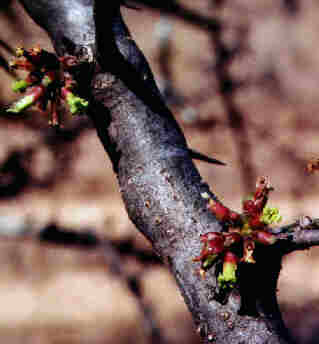
Plant Description
Caution & Interaction

Latin (botanical) name:
Commiphora myrrha
Common names: Gum Myrrh Tree
Plant Description: Myrrh trees grow on arid, rocky hills of the deserts of Arabia, Ethiopia, and Somalia. They are virtually non-destructible and can survive under the harsh conditions of the desert. The trees themselves grow to no more than 9 feet in height, but they are extremely sturdy. They have trifoliate leaves, although few at best, that are small and oval. Myrrh trees produce a fragrant, pale yellow to brown resin that seeps out of splits in the bark and hardens into reddish-brown globules called 'tears', about the size of a walnut. For thousands of years, these tears have been collected and placed over coals to produce a fragrant smoke. The surface of the gum is rough and powdered, the pieces brittle, semi-transparent, and oily. They have a granular fracture and sometimes show white marks. The odor is pleasant, but the taste is bitter and acrid.
Medicinal Properties &Uses: Myrrh trees contain volatile oil, resin called "myrrhin", gum, ash, salts, sulphates, benzoates, malates, and acetates of potassa. The anti-infectious, bacteriostatic, and antiseptic properties of Myrrh make it especially effective in treating digestion by acting quickly and directly on the peptic glands to increase activity, and on infection, and vaginatis. It has been known to effectively treat chronic catarrh, pulmonalis, and amenorrhoea. It is an expectorant, in the absence of feverish symptoms, and a stimulant and antiseptic to the mucous tissues. As a stomachic carminative, it excites appetite and the flow of gastric juice. The volatile oil contained in Myrrh is ideal for opening up congestion and mucous clogging passages. The circulation is increased by stimulation of the capillary activity, and it promotes absorption of nutrients and increases the number of white blood cells. Myrrh is also excellent as a gargle and/or mouthwash for toothache, sore gums, cankers in the mouth and throat, and asthma. The disinfectant properties make Myrrh exceptional for washing wounds or as a douche.
Dosage: 30-60 drops in water or juice, 2-3 times daily or as needed. Shake well before using.
Cautions & Interactions: Do not take during pregnancy. Keep out of reach of children.
Efficacy Studies & Other Clinical Data: Helpful Links:
Disclaimer (U.S. Only): These statements have not been evaluated by the FDA. These products are not intended to diagnose, cure, treat, or prevent any disease.
Common names: Gum Myrrh Tree
Plant Description: Myrrh trees grow on arid, rocky hills of the deserts of Arabia, Ethiopia, and Somalia. They are virtually non-destructible and can survive under the harsh conditions of the desert. The trees themselves grow to no more than 9 feet in height, but they are extremely sturdy. They have trifoliate leaves, although few at best, that are small and oval. Myrrh trees produce a fragrant, pale yellow to brown resin that seeps out of splits in the bark and hardens into reddish-brown globules called 'tears', about the size of a walnut. For thousands of years, these tears have been collected and placed over coals to produce a fragrant smoke. The surface of the gum is rough and powdered, the pieces brittle, semi-transparent, and oily. They have a granular fracture and sometimes show white marks. The odor is pleasant, but the taste is bitter and acrid.
Medicinal Properties &Uses: Myrrh trees contain volatile oil, resin called "myrrhin", gum, ash, salts, sulphates, benzoates, malates, and acetates of potassa. The anti-infectious, bacteriostatic, and antiseptic properties of Myrrh make it especially effective in treating digestion by acting quickly and directly on the peptic glands to increase activity, and on infection, and vaginatis. It has been known to effectively treat chronic catarrh, pulmonalis, and amenorrhoea. It is an expectorant, in the absence of feverish symptoms, and a stimulant and antiseptic to the mucous tissues. As a stomachic carminative, it excites appetite and the flow of gastric juice. The volatile oil contained in Myrrh is ideal for opening up congestion and mucous clogging passages. The circulation is increased by stimulation of the capillary activity, and it promotes absorption of nutrients and increases the number of white blood cells. Myrrh is also excellent as a gargle and/or mouthwash for toothache, sore gums, cankers in the mouth and throat, and asthma. The disinfectant properties make Myrrh exceptional for washing wounds or as a douche.
Dosage: 30-60 drops in water or juice, 2-3 times daily or as needed. Shake well before using.
Cautions & Interactions: Do not take during pregnancy. Keep out of reach of children.
Efficacy Studies & Other Clinical Data: Helpful Links:
Disclaimer (U.S. Only): These statements have not been evaluated by the FDA. These products are not intended to diagnose, cure, treat, or prevent any disease.